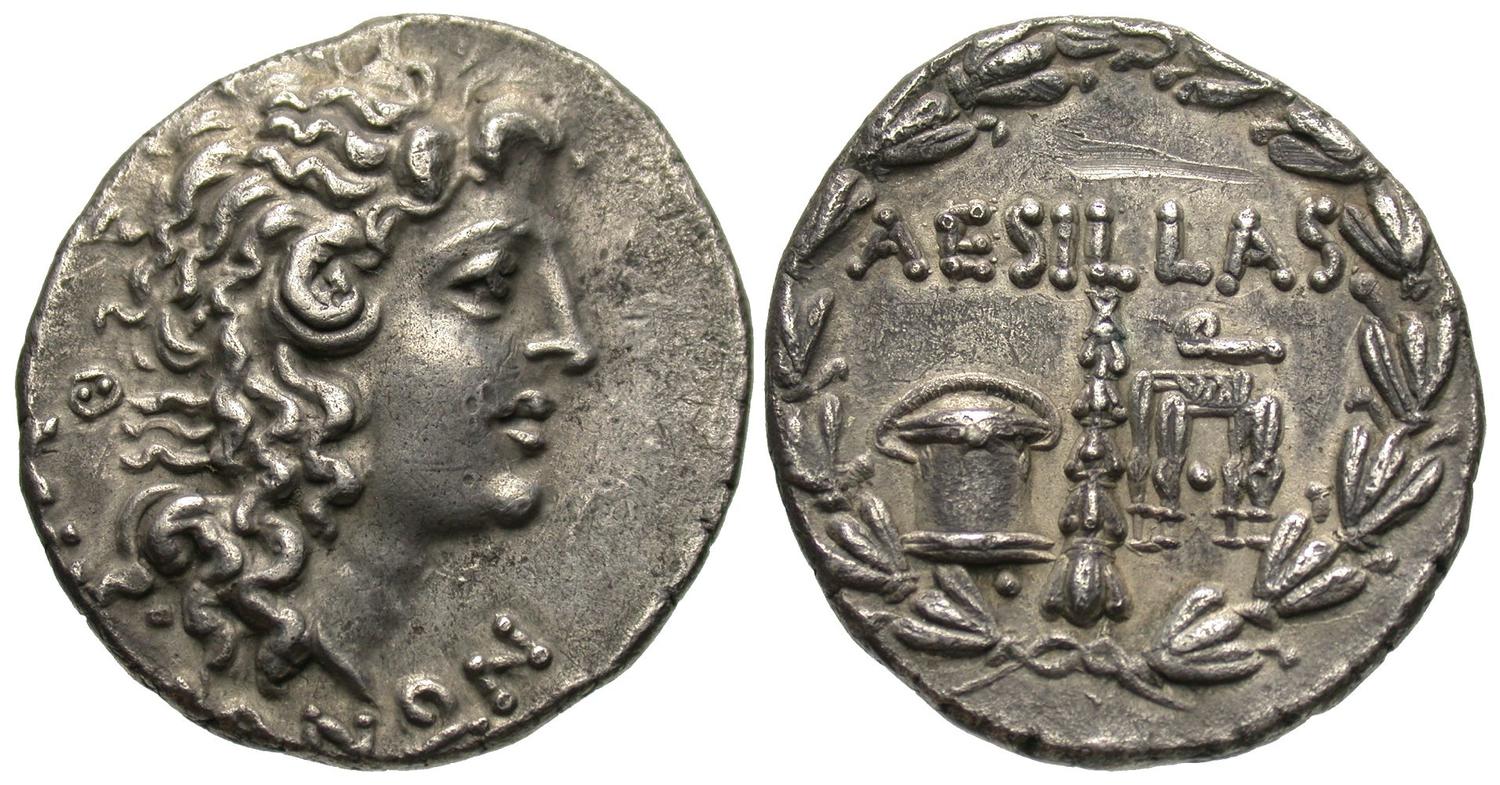Thessalonica? (Aesillas), silver, tetradrachms (100-65 BCE) Bauslaugh
From SILVER
100 BCE - 65 BCE Silver 35,071 kg
Description
| ObverseInscription or printing placed on the obverse.: | Various legends: 1) MAKEΔΟΝΩΝ ; 2) CAE PR MAKEΔΟΝΩΝ ; 3) S I MAKEΔΟΝΩΝ (Greek; Latin).Diademed head of Alexander the Great right. |
| ReverseInscription or printing placed on the reverse.: | Various legends: 1) AESILLAS Q. ; 2) SVVRA LEG PRO Q (Latin).Money chest, club and chair, all within wreath. |
Mint and issuing power
| MintIdentifies the place of manufacture or issue of a numismatic object.: | Thessalonica | Ancient regionAncient region.: | Macedon | Modern countryModern country: Greece | AuthorityIdentifies the issuing power. The authority can be "pretended" when the name or the portrait of X is on the coin but he/she was not the issuing power. It can also be "uncertain" when there is no mention of X on the coin but he/she was the issuing power according to the historical sources: | Aesillas (quaestor in the Roman province of Macedonia in c. 90 BC), Roman Republic, Roman province of Macedonia |
Chronology
| FromIdentifies the initial date in a range assigned in a numismatic context. | 100 BCE | toIdentifies the final date in a range assigned in a numismatic context.. | 65 BCE | PeriodTime period of the numismatic object.: Hellenistic 323-30 BC |
Physical description
| MetalThe physical material (usually metal) from which an object is made.: | Silver |
Median weightMedian of the weights of numismatic objects (in grams). in grams | 16.90 | DenominationTerm indicating the value of a numismatic object. Examples: tetradrachm, chalkous, denarius.: | tetradrachm |
StandardStandard.: | Attic |
Image

H134 Alexander the Great Aesillas.jpeg [1]
References
| Die study referencePublication of the study: | Bauslaugh 20001Bauslaugh 2000 | ||
| Coin series referenceReference to coin series study: | Sear I2Sear I, n° 1463-1464, RQEMH3RQEMH, n° 134, HGC 3.14HGC 3.1, n° 1110 | ||
| Coin series web referenceCoin series web references: | |||
Obverse dies distribution
| FrequencyFrequency of specimen in distribution. ᵖ | Number of obversesNumber of obverse dies. ᵖ (o) | % (o) | Number of coinsNumber of coins. (n) | % (n) | Die nameName(s) of the die(s). |
| 1 | 34 | 33.33 | 34 | ||
| 2 | 11 | 10.78 | 22 | ||
| 3 | 8 | 7.84 | 24 | ||
| 4 | 10 | 9.8 | 40 | ||
| 5 | 3 | 2.94 | 15 | ||
| 6 | 11 | 10.78 | 66 | ||
| 7 | 2 | 1.96 | 14 | ||
| 8 | 5 | 4.9 | 40 | ||
| 9 | 8 | 7.84 | 72 | ||
| 10 | 3 | 2.94 | 30 | ||
| 11 | 2 | 1.96 | 22 | ||
| 12 | 1 | 0.98 | 12 | ||
| 13 | 1 | 0.98 | 13 | ||
| 17 | 1 | 0.98 | 17 | ||
| 18 | 1 | 0.98 | 18 | ||
| Total | 101 of 102 | 98.99 | 439 of 1,000 |
Reverse dies distribution
no distribution is available
Quantification
| Number of obversesNumber of obverse dies. ᵖ (o) | 102 | Number of singletons (o1)The number of singleton coins. ᵖ | |
| Number of reverse diesNumber of reverse dies. (r) | 377 | Number of coinsNumber of coins. (n) | 1000 |
| Coins per obverse dieNumber of coins per obverse die. (n/o) | 9.8 | Coins per reverse dieNumber of coins per reverse die. (n/r) | 2.65 |
| Reverse per obverse ratioRatio of obverse dies divided by reverse dies. (r/o) | 3.7 | Percentage of singletons (o1)number of coins (n) divided by the number of singletons (o1) ᵖ | % |
| Original number of dies (O) (Carter 1983 formula)The estimation of the number of coins according to Carter 1983 ᵖ | 103.76 | Coins struck if 20,000 as average productivity per dieCoins made if the average productivity for obverses (according to Carter) is 20,000. ᵖ | 2,075,200 |
| Original number of dies (O) (Esty 2011 formula)The estimation of the number of coins according to the singleton formula in Esty 2011 ᵖ (O) | 113.59 | Survival rate if 20,000 as average productivity per dieSurvival rate if average productivity is 20,000. ᵖ | 0.00048 |
| Coverage (o = % of O) (Esty 1984 formula)Esty 1984 - coverage (% of O) ᵖ (o = % of O) | % | Die productivity if survival rate 1/2,000Average productivity if survival rate is 1/2,000. ᵖ | 19,275.25 |
| Weight of silver (in kg) if 20,000 coins per die (O = Carter formula)Carter 1983 * Median weight * 20000 (*10 if gold or electrum) ᵖ | 35,071 kg <br /> 35,071 kg | Die productivity if survival rate 1/5,000Average productivity if survival rate is 1/5,000. ᵖ | 48,188.13 |
Remarks
Most likely one single workstation Certainly military